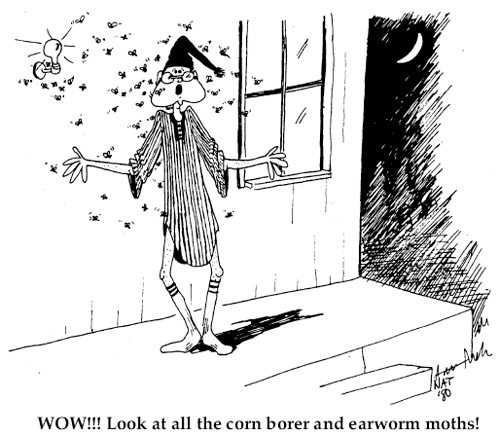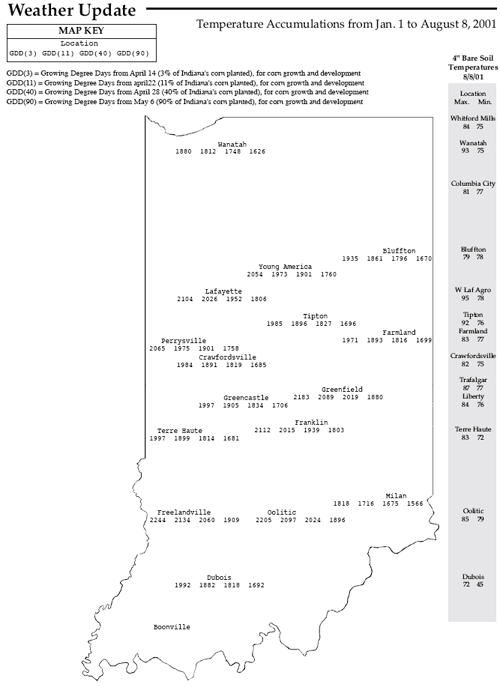Pest & Crop Newsletter
|
||||||||
What's Going On With Soybean Aphid?– (John Obermeyer, Rich Edwards, and Larry Bledsoe)
Reports from within and outside Indiana have yielded a mixed bag concerning soybean aphid. A few pest managers in northern counties have noticed significant populations, even to the point where some plant yellowing and stunting are becoming apparent. Almost all fields with higher aphid populations have been late maturing soybean (late planted or late maturity groups). In addition, aphid reductions and even population crashes are being seen. The same phenomena have been reported in surrounding states. Some have suggested that we may have seen the peak of population, while others aren’t so sure. What’s going on? Certainly with it being a new pest to this country there is a lot to be learned. We understand its reproductive capability, that being potentially explosive, but the many interacting factors (e.g., environment, predators, parasites, pathogens, varieties, planting date, etc.) are a mystery. Researchers visiting China and Japan this past month noticed subtle and dramatic differences in their dynamics with regard to distribution within a field, natural enemies, and impact on different soybean cultivars. This only complicates matters when trying to apply soybean aphid knowledge from Asia to the United States. To boot, there have been obvious infestation level differences among states within the North Central region, with the more northerly states having higher populations. Nobody knows for sure when is the best time to treat for soybean aphid, a.k.a., economic threshold. There has been much discussion about aphids/plant and aphids/trifoliolate leaves, etc., but no hard and fast rules. We feel strongly that commercial soybean fields should not be treated until symptoms become evident. When areas of a field are beginning to yellow (much like soybean cyst nematode) and soybean aphids are quite evident (live aphids and sticky plants from honeydew) as you walk through the field, then treatment may be justified. It is extremely important to assess aphid-infested fields for beneficial organisms before management decisions are made. Predators, mostly lady beetles, have been very active and in some fields aphids have literally disappeared within days. Additional information and color pictures can be downloaded (pdf) and viewed in extension publication E-217, Soybean Aphid, at: <http://www.entm.purdue.edu/entomology/ext/targets/e-series/EseriesPDF/E-217.pdf>.
Continue to Monitor High Value Crops Susceptible to Earworm and Corn Borer– (John Obermeyer, Rich Edwards, and Larry Bledsoe) As mentioned last week, moth flights of corn earworm and European corn borer continue to remain high. This is being observed in pheromone and black light traps, as well as nighttime windshield splatters. High value field and vegetable crops should be monitored until physiological maturity of plants no longer makes them attractive for egg laying (e.g., brown silks). It is highly unlikely that one could economically justify treating commercial field corn.
Stinging Caterpillars– (John Obermeyer, Rich Edwards, and Larry Bledsoe)
Though crops aren’t exactly inviting this time of year for making observations, “dyed in the wool” pest managers continue to monitor for insect and weed pests. Occasionally at this time of year, peculiar looking caterpillars can be found feeding on the leaves of corn and soybean. Look carefully before you touch! Two species, the Io moth and the saddleback caterpillar, found in fields can sting when handled! Though both species can be found on many different plants, in field crops the Io feeds on both corn and soybean, while the saddleback is only encountered in corn. The bodies of these caterpillars are covered with “stinging” or “nettling” hairs, which produce a stinging sensation and temporary rash when the caterpillars come into contact with the skin. These stinging hairs resemble spines; whereas the often encountered and harmless woollybear is just hairy looking. To add confusion to the matter, there are many more formidable looking caterpillars found on various plant species that are harmless. The old adage “when in doubt, leave it alone” applies here. Color pictures of Io and saddleback caterpillars are available in the 2000 revision of the Field Crops Pest Management Manual. Happy Scouting!
|
||||||||
Soybean Viruses and the Soybean Aphid 2001 Survey– (Keith Perry) Cooperative research in the Departments of Botany and Plant Pathology and Entomology at Purdue is addressing the newly introduced soybean aphid and its potential to transmit viruses. The soybean aphid is an exotic species with the ability to colonize and reproduce on soybeans. Scouting and sampling of soybeans at the Agronomy Research Center in West Lafayette during July 2001 revealed that virus infected plants were quite rare. Of the three viruses detected, bean pod mottle, tobacco ringspot, and soybean mosaic, only the latter is known to be efficiently transmitted by aphids. A call for samples! During the 2001 growing season, soybeans are being sampled to determine what viruses are present and to evaluate the potential for the soybean aphid to transmit these viruses. Your willingness to provide samples of plants with virus–like symptoms would be greatly appreciated. Put leaf samples in a paper envelope or bag (not plastic) and send by mail to the address below. The type of material desired is leaf material collected from sites with plants exhibiting symptoms of virus infection (leaf mottling, mosaic, or distortion). The sampling unit is ten trifoliate leaves, each leaf collected from a separate plant (if possible) at the same site. Leaves from non-symptomatic plants of the same variety at the same site are desired, but not essential. Regarding handling, the ten trifoliate leaves can be placed in the same paper bag or envelope; leaves collected from non-symptomatic plants should be kept separate. Mark samples as to soybean variety (if known) and collection site. Please include your name and a contact phone number or email address. For further information, contact Keith Perry at 765-494-4640 or perry@btny.purdue.edu. Samples should be sent to: Dr. Keith Perry, Department of Botany and Plant Pathology, 1155 Lilly Hall, Purdue University, W. Lafayette, IN 47907.
|
||||||||
Yellow Soybeans After Glyphosate Applications– (Bill Johnson, Univ of Missouri-Columbia) We have received a few reports of yellow soybean leaves following application of glyphosate-based products and wanted to take this opportunity to address the issue in this article. The injury is described as a yellow or lemon-lime green color of newly emerging trifoliolates following a glyphosate application. Typically, the veins of the affected leaf remain green and the yellowing is more or less uniformly distributed across the leaf surface. This has been a relatively common occurrence over the last few seasons and can be caused by the following conditions:
Although thepresence of crop response to glyphosate may cause concern, keep in mind that it is transitory in nature and usually not present by 10 to 14 days after application unless beans are under additional stresses mentioned above. If two to four trifoliolates are affected and then the plant grows normally, there will not be an effect on yield. We have observed much more severe damage to soybean with diphenyl ether herbicides (Cobra, Blazer, Reflex) in the past and not had a significant effect on yield, so the response to glyphosate is really minor in comparison. This article was taken from: Integrated Pest & Crop Management Newsletter, University of Missouri-Columbia, Vol. 11, No. 20, Article 1 of 7, August 10, 2001. This article was also featured in the Volume 10, Number 18 edition of Integrated Pest and Crop Management Newsletter.
Soybean Flowering and Flower Abscission– (Bill Wiebold, Univ. of Missouri-Columbia) Initiation of soybean flowering is strongly influenced by photoperiod. Soybean is a short day species and usually flowers after the first day of summer. Other factors, including temperature and plant age, also affect the timing of flowering. As a rule of thumb, delaying planting 3 days delays flowering about 1 day. Because of the strong photoperiod sensitivity, soybean varieties are adapted to relatively narrow bands. These Maturity Group bands are about 125 to 150 miles wide and extend across North America roughly parallel to latitude. In most instances, we do not recommend planting unadapted varieties. Varieties that mature earlier than adapted varieties often will be shorter and yield less. Varieties that mature later than normal may grow too tall, lodge and may be harmed by frost. However, producers in southern Missouri and southern states may benefit from planting varieties from early, unadapted Maturity Groups. The primary benefit is increased yield from avoiding dry weather in late August or early September. Soybean flowers are borne on raceme inflorescences. Flowers and the resulting pods connect to the central rachis of the raceme with small stalks or pedicels. Each stem and branch node contains three buds that under proper stimuli may form an inflorescence. Each inflorescence produces from two to more than ten flowers, so the flowering capacity of a soybean plant is considerable. Not all of these flowers produce pods that remain on the plant until harvest. For a typical soybean plant, 40 to 70% of the flowers abscise. The reproductive structure that abscises is actually a small pod because nearly all flowers undergo self-fertilization. Although even fairly large pods can abscise, most pods that will abscise do so within 14 days of fertilization. The greatest amount of abscission usually occurs late in pod development or early seed filling. It is not uncommon to observe fairly large numbers of small pods lying on the leaves and ground. Producers may be concerned, but they should be reminded that abscission is a normal defense mechanism of soybean. Adverse weather such as dry weather or defoliation by hail can increase the amount of abscission. Biotic factors such as diseases or insect feeding can also lead to more abscission than normal. Typically these factors reduce the ability of leaves to supply sugars for pod and seed growth. Some insects feed directly on soybean petals, but this damage does not usually affect pod development or increase abscission. This article was taken from: Integrated Pest & Crop Management Newsletter, University of Missouri-Columbia, Vol. 11, No. 20, Article 6 of 7, August 10, 2001.
|
||||||||
|
||||||||






